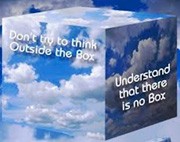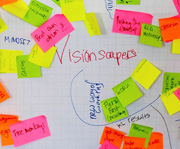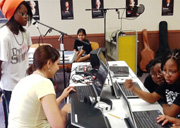Library Innovation: There is No Box

“Innovation is not technology; it’s a way of thinking.”
To help us engage in innovative thinking, we need new metaphors and strategies. That was a key message in the webinar The Future is Now: Rural Library as Innovation Incubator. Although presenters Tameca Beckett and Andrea Berstler emphasized the benefits of a small community as a breeding ground for innovation, the concepts apply broadly.
Two metaphors in need of a refresh
Metaphors, although useful for framing concepts and approaches, can get stale and lose strength over time. Beckett and Berstler suggested a refresh for these two common ones.
1. Glass half-full/empty: How many times have you been asked to identify yourself as a glass-half-full or a glass-half-empty person? With either choice, the focus is on a static level of content in the glass. How about seeing the amount of space in the glass as potential not being realized? Focus on filling the glass, maybe to overflowing, maybe even shatter the glass. Which leads to the next metaphor…
2. Think outside the box: Thinking outside the box keeps the focus on the parameters of the box; ideas generated still tend to refer back to the box or current framework. Think of how kids play with a box: “they don’t see a box; they see an opportunity.” They board the pirate ship or crawl through the cave, not stopping to think about the boxness of their new playground. Read the No Box Blog to help unbox your thinking.
Two durable strategies
 1. Thinking time: In our hyper-loaded work lives, we rarely take time to stop and think. Yet it’s that kind of unstructured, mind-wandering time that can lead to breakthrough thinking. Berstler challenges us to dedicate 1% of our time—21 minutes a week—to sit down with pencil and paper and think about possibilities. Start without limitations (no box), conjuring up what you would do if anything was possible; then ask “why can’t I do it now?” Use a problem design approach that starts before a product or service is even conceived. With the creative focus on a problem that exists, the thought process of potential solutions may go in circles or generate crazy ideas. The objective is not to stay on a linear path toward a pre-defined goal; it’s to get off that path and see what bubbles to the surface that might lead to real change.
1. Thinking time: In our hyper-loaded work lives, we rarely take time to stop and think. Yet it’s that kind of unstructured, mind-wandering time that can lead to breakthrough thinking. Berstler challenges us to dedicate 1% of our time—21 minutes a week—to sit down with pencil and paper and think about possibilities. Start without limitations (no box), conjuring up what you would do if anything was possible; then ask “why can’t I do it now?” Use a problem design approach that starts before a product or service is even conceived. With the creative focus on a problem that exists, the thought process of potential solutions may go in circles or generate crazy ideas. The objective is not to stay on a linear path toward a pre-defined goal; it’s to get off that path and see what bubbles to the surface that might lead to real change.
2. One step at a time: Start with small tests of change. The small steps will accumulate to a point at which the community notices a “big change.” You don’t need to achieve perfection in order to launch any new service. We live in a society that understands beta-testing. Iterative development is becoming the norm, in part due to the pressures of rapid change, but also because the benefits are becoming ever more apparent. Berstler recruits her library visitors as beta-testers. It’s free usability testing. The library gets valuable input on the user experience; the users get engaged and enthused about the library.
Two examples of big thinking in small libraries
 1. Upon reading about a flashy $10K digital media lab at another library, Beckett’s first thought was “oh wow, that’s not going to happen.” Then she took some reflection time, slowed down her thinking, took the problem apart piece-by-piece, and started to find a direction forward. She identified some key components to start with and purchased $400 worth of basic hardware and software tools. With the impression this starter lab made on her patrons and community stakeholders, she and her director found a community agent to fund a more complete digital media lab. “It went from this big huge scary thing that could never happen to look at these young people right now using the digital media lab.”
1. Upon reading about a flashy $10K digital media lab at another library, Beckett’s first thought was “oh wow, that’s not going to happen.” Then she took some reflection time, slowed down her thinking, took the problem apart piece-by-piece, and started to find a direction forward. She identified some key components to start with and purchased $400 worth of basic hardware and software tools. With the impression this starter lab made on her patrons and community stakeholders, she and her director found a community agent to fund a more complete digital media lab. “It went from this big huge scary thing that could never happen to look at these young people right now using the digital media lab.”
2. Berstler couldn’t figure out what to do with the dead space in the over-sized lobby of the main library. “It was my box.” The problem was an unused space subject to theft and loitering. At the same time, the Friends group wanted to be able to sell books beyond the annual booksale. The two problems converged on a solution. By pulling furniture and fixtures from storage, doing fundraisers to build a new glass wall, and enlisting volunteer labor, the space was transformed. The new light-filled bookstore attracts the community and increases Friends’ income, but, as Berstler says, that is secondary. The big win was how the community came together to contribute to the solution. “Your community has the answer for its problems. You just have to help them find it.”
Jami Carter, creator of the amazing Self-Directed Achievement program, chimed in through chat with these wise words: “Set your sights high... you'll amaze your community... And be proud if you ALMOST made your goal, because you are far from where you started!”
